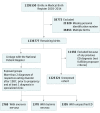Association of Maternal Eating Disorders With Pregnancy and Neonatal Outcomes
- PMID: 31746972
- PMCID: PMC6902173
- DOI: 10.1001/jamapsychiatry.2019.3664
Association of Maternal Eating Disorders With Pregnancy and Neonatal Outcomes
Erratum in
-
Error in Surname of Contributing Author.JAMA Psychiatry. 2020 Mar 1;77(3):328. doi: 10.1001/jamapsychiatry.2019.4578. JAMA Psychiatry. 2020. PMID: 31895436 Free PMC article. No abstract available.
Abstract
Importance: The prevalence of eating disorders is high among women of reproductive age, yet the association of eating disorders with pregnancy complications and neonatal health has not been investigated in detail, to our knowledge.
Objective: To investigate the relative risk of adverse pregnancy and neonatal outcomes for women with eating disorders.
Design, setting, and participants: This population-based cohort study included all singleton births included in the Swedish Medical Birth Register from January 1, 2003, to December 31, 2014. A total of 7542 women with eating disorders were compared with 1 225 321 women without eating disorders. Statistical analysis was performed from January 1, 2018, to April 30, 2019. Via linkage with the national patient register, women with eating disorders were identified and compared with women free of any eating disorder. Eating disorders were further stratified into active or previous disease based on last time of diagnosis.
Main outcomes and measures: The risk of adverse pregnancy outcomes (hyperemesis, anemia, preeclampsia, and antepartum hemorrhage), the mode of delivery (cesarean delivery, vaginal delivery, or instrumental vaginal delivery), and the neonatal outcomes (preterm birth, small and large sizes for gestational age, Apgar score <7 at 5 minutes, and microcephaly) were calculated using Poisson regression analysis to estimate risk ratios (RRs). Models were adjusted for age, parity, smoking status, and birth year.
Results: There were 2769 women with anorexia nervosa (mean [SD] age, 29.4 [5.3] years), 1378 women with bulimia nervosa (mean [SD] age, 30.2 [4.9] years), and 3395 women with an eating disorder not otherwise specified (EDNOS; mean [SD] age, 28.9 [5.3] years), and they were analyzed and compared with 1 225 321 women without eating disorders (mean [SD] age, 30.3 [5.2] years). All subtypes of maternal eating disorders were associated with an approximately 2-fold increased risk of hyperemesis during pregnancy (anorexia nervosa: RR, 2.1 [95% CI, 1.8-2.5]; bulimia nervosa: RR, 2.1 [95% CI, 1.6-2.7]; EDNOS: RR, 2.6 [95% CI, 2.3-3.0]). The risk of anemia during pregnancy was doubled for women with active anorexia nervosa (RR, 2.1 [95% CI, 1.3-3.2]) or EDNOS (RR, 2.1 [95% CI, 1.5-2.8]). Maternal anorexia nervosa was associated with an increased risk of antepartum hemorrhage (RR, 1.6 [95% CI, 1.2-2.1]), which was more pronounced in active vs previous disease. Women with anorexia nervosa (RR, 0.7 [95% CI, 0.6-0.9]) and women with EDNOS (RR, 0.8 [95% CI, 0.7-1.0]) were at decreased risk of instrumental-assisted vaginal births; otherwise, there were no major differences in mode of delivery. Women with eating disorders, all subtypes, were at increased risk of a preterm birth (anorexia nervosa: RR, 1.6 [95% CI, 1.4-1.8]; bulimia nervosa: RR, 1.3 [95% CI, 1.0-1.6]; and EDNOS: RR, 1.4 [95% CI, 1.2-1.6]) and of delivering neonates with microcephaly (anorexia nervosa: RR, 1.9 [95% CI, 1.5-2.4]; bulimia nervosa: RR, 1.6 [95% CI, 1.1-2.4]; EDNOS: RR, 1.4 [95% CI, 1.2-1.9]).
Conclusions and relevance: The findings of this study suggest that women with active or previous eating disorders, regardless of subtype, are at increased risk of adverse pregnancy and neonatal outcomes and may need increased surveillance in antenatal and delivery care.
Conflict of interest statement
Figures


References
Publication types
MeSH terms
LinkOut - more resources
Full Text Sources
Medical
Miscellaneous

